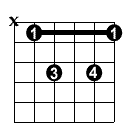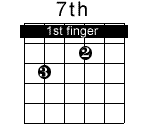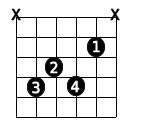Dominant 7th chords are labeled with a 7. For example, C7.
Our first version of the 7th chord finds it’s root on the 5th string:

It’s fairly easy to play. It’s very similar to an A style barre chord with only the note on the G string being different. Here are all 12 variations:

Practice it as you’ve done the other chords. Play the chord up and down the neck. Can you name the chords as you go along?
Here’s another 7th chord form. It uses all six strings. Its root is on the 6th string. Use it to identify the name of the chords as you play them.


In the open position we begin with E7, next comes F7 where the root is on the 1st fret (F note). It continues up the fretboard until we get all 12 possible variations.

It’s pretty easy to learn to play this version of the 7th chord, but you still must practice it so that you don’t forget it:
Here we are with yet another version of the dominant 7th chord. It’s my personal favorite version of the chord:

Did you notice anything different? Yep, we’re going to use our thumb to fret the root note on the low E string. It’s virtually the same as the previous chord that we learned except we’re omitting the notes on the A and high E strings. It’s a fun chord to play, so try it:

Practice it up and down the fretboard. For extra credit you can call out the names of the chords as you play them:
Finally, here’s yet another version of the dominant 7th chord. They may be technically the same types of chords, but each version has its own character:

